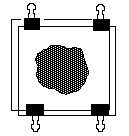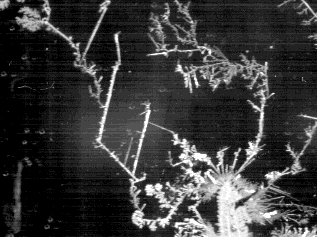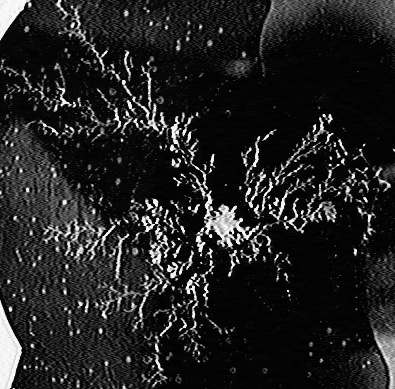
We were interested in looking at silver formations by combining silver nitrate with copper. Our hypotheses were:
Materials Needed:
Lucite or similar plastic 6" X 6" squares
coverslips
clamps
copper wire and various shapes of copper
silver nitrate
distilled water
plastic gloves
safety glasses
"Fractional Dimension" software (may be downloaded from Patterns in
Nature website http://polymer.bu.edu/)
Various sizes and shapes of copper will be placed with silver nitrate solutions in order to observe fractals. Reaction site will be between two plastic squares. A flat, two dimensional reaction will occur.
Procedure Part I: Variation in Size/Shape of Copper

1. Make a 100 ml solution of 0.5 molar silver nitrate in distilled water.
2. Cut various sizes and shapes of copper wire and copper pieces. (We used three 2mm X 2mm squares to test variations of silver nitrate concentrations. We cut fractals: a lightning bolt, geometric - triangles, and curved shapes.)
3. Get two Lucite or similar plastic 6" X 6" squares.
4. Place two coverslips on top of each other in each corner of one of the Lucite squares.
5. Place one of the pieces of copper in the center of one plastic square. Do not use the small 2mm X 2mm squares.
6. Pour 10 ml of the silver nitrate solution on and around the copper.
7. Carefully place the second plastic square on top to avoid air bubbles.
8. Place clamps on the four corners.
9. Make observations.
10. Repeat procedure with all remaining shapes other than the small 2mm X 2mm squares.
11. After making observations, place in a safe place until the following day.
Procedure Part II: Variation in Concentration of Silver Nitrate
12. Prepare dillutions of silver nitrate as follows: 50 ml each of 0.1 M, 0.25 M, silver nitrate in distilled water.
13. Repeat steps 3 - 11 using three 2mm X 2mm copper squares with the three concentrations of silver nitrate.
14. Observations may be made using a hand lens, scanner, video cam hook-up, video microscope.
15. "Fractal Dimension" software may be used to calculate the fractal dimensions and make comparisons.
Observations:
1. Every sample showed formation of silver. The diagram below shows an example of a fractal produced along the edge of lightning shaped copper.

Figure 1 - Fractal Pattern from Lightning Shaped Copper Sheet
2. Silver was concentrated at the edges of the copper, branching outward into fractal patterns.
3. Fractals were more pronounced from the apices of copper.
4. Silver fractals appeared more dense at the edges of copper and became increasingly finely branched at the tips.
5. As concentration of silver nitrate increased, the fractal pattern was shorter in length however the silver was more dense.
6. Fractal dimensions for all shapes varied between 1.53 and 1.79 using the box method. The circle method gave similar results only when the center of the circle was along the branches. See Table 1 for data.
| Concentration of AgNO3(M) | Fractal Dimension Using Box Method | |
|---|---|---|
| Large Disk | 0.5 | 1.79 |
| Small Disk | 0.5 | 1.67 |
| Lightning Pattern | 0.5 | 1.53 |
7. As the concentration of silver nitrate increased, the fractal pattern reduced in size. Data is shown in Table 2 and the fractal pattern for 0.1M AgNO3 is shown in Figure 2.
| Concentration of AgNO3(M) | Radial Spread of Silver Fractal (cm) | Fractal Dimension |
|---|---|---|
| 0.1 | 5.9 | 1.45 |
| 0.25 | 2.1 | 1.54 |
| 0.50 | 1.3 | 1.67 |

Figure 2: Fractal Pattern using 0.1M AgNO3
The purpose of the experiments was to investigate the patterns formed by various shapes of copper as well as varying solutions of silver nitrate. The reaction resulted in exquisite silver fractals.
Circular and square shaped copper pieces formed branched, radial patterns. Shapes with apices showed areas with high concentrations of growth. Fractal dimension of each shape varied between 1.5 and 1.7.
Increasing the concentration of silver nitrate did not produce a larger pattern as expected. In fact the most branched and spread out pattern was obtained with the smallest concentration as shown in Figure 2.
Copper silver nitrate reaction provides an excellent demonstration of fractal patterns. As an extension, other single displacement reactions could be investigated.